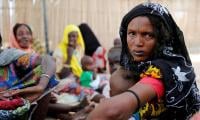The implementation conundrum
The government of Punjab has been in the limelight recently for carrying out much needed legislation, such as prohibiting child labour at brick kilns and curbing violence against women. While the implementation of these laws is not that easy, it is encouraging that the government machinery is active, especially in the case of brick kilns, and has put many owners behind bars for failing to eliminate child labour at their kilns.
The objective of this law is not only to end child labour, it is also aimed at enrolling these children in schools and providing them with quality education. The burden, undoubtedly, is on the government to get these children to school. There are millions of out-of-school children in the province, who have the constitutional right to education that has been denied them so far. There are official commitments, like those of achieving the goal of Education for All (EFA) and meeting targets set for primary and secondary education in the Sustainable Development Goals (SDGs) for 2030.
Against this backdrop, the government of Punjab approved the Punjab Free and Compulsory Education Act in May 2014. The objective was to implement the constitutional amendment of Article 25-A to provide free and compulsory education to all children aged 5-16 years. The law also requires the government or local authorities to establish kindergarten schools or childcare centres in local areas to provide free pre-school education and early childhood care to children above the age of three years until they join a school.
The passage of this law is no doubt a commendable feat, but the fact that the implementation mechanism and rules of business have not yet been worked out is a matter of grave concern. The law will be of no use to anyone and the ambitious enrolment schemes will not succeed until the implementation mechanisms are framed. One possible reason for the delay is that the government has set up very ambitious targets (which it knows are hard to meet). This is something that the government circles deny altogether.
However, they agree that the implementation of this law would be challenging in terms of arranging resources, setting up infrastructure, recruiting teachers and creating the demand for education in communities so that they send their children to school. Another question is whether it will be possible for the government to bear all the costs of education, including those of uniforms, books, stationery, transport, and examination fees charged by the boards.
The law does focus on these aspects. For example, it says that the government may permit a school management body to establish, in the prescribed manner, a ‘taleem fund’ for the school, into which voluntary contributions from philanthropists, alumni, students and parents shall be deposited. Private-sector schools are supposed to admit a certain number of deserving children, who must comprise 10 percent of each class, and provide free and compulsory education to them.
Penalties and punishments have also been defined for parents, teachers, schools and government functionaries – ranging from mild to harsh. For example, if a parent fails to admit and keep a child in school, he or she will not be entitled to any subsidy or poverty-targeted support of the government. Under Section 20, if a person contravenes any order made under this act, he or she shall be punished with imprisonment for a term that may extend to six months, a fine of up to Rs50,000 or both.
The government must not delay the implementation of this law, which was passed two years ago, any further. But at the same time, it must realise that it cannot shirk its responsibilities and hope that individual donors and the private education sector will fulfil them. The government has to accept that it will be difficult to implement this law, unless the education budget is increased or a special budget for the implementation of the law is allocated. Issues of the timely release of funds and the underutilisation of funds by the education department will also have to be addressed.
Furthermore, the non-availability of sufficient public schools and disparity among different districts of the province are major stumbling blocks. There are not enough public schools to accommodate all the school-going children, particularly in the rural areas. There are fewer girls’ schools as compared to boys’ schools. There is also a disparity among districts in the number of schools, due to the inappropriate allocation of resources and political favouritism that has prevailed for years.
Poverty is considered one of the main challenges that constrains poor children’s access to education. Therefore, it is important for the government of Punjab to identify the income groups of parents that are unable to send their children to schools, and address the financial constraints of those families to encourage them to send their children to schools.
Last but not the least, private-sector schools can play a role but the government should be realistic. It must understand that the private sector may not be ready to bear this burden, especially when they are protesting against the government for not allowing them to raise tuition fees. Perhaps an incentives policy for schools to share this social responsibility will help.
The writer is a journalist with this newspaper.
Email: shahzada.irfan@gmail.com
-
 Apple Foldable IPhone Tipped For 2026 Launch With A20 Pro Chip And C2 Modem
Apple Foldable IPhone Tipped For 2026 Launch With A20 Pro Chip And C2 Modem -
 Meghan Lends Credence To Reports Of Rift With Kim Kardashian On Chicago's Birthday
Meghan Lends Credence To Reports Of Rift With Kim Kardashian On Chicago's Birthday -
 Florida Woman’s Alleged Bid To Bribe Police Ends In Unexpected Discovery
Florida Woman’s Alleged Bid To Bribe Police Ends In Unexpected Discovery -
 James Van Der Beek Strongly Opposes The Idea Of New Year In Winter
James Van Der Beek Strongly Opposes The Idea Of New Year In Winter -
 Elon Musk’s Starlink Rival Eutelsat Partners With MaiaSpace For Satellite Launches
Elon Musk’s Starlink Rival Eutelsat Partners With MaiaSpace For Satellite Launches -
 Fans Feel For Leonardo DiCaprio As He Gets Awkwardly Snubbed: Watch
Fans Feel For Leonardo DiCaprio As He Gets Awkwardly Snubbed: Watch -
 Japan Launches The World’s First Trial To Extract Rare Earth Elements
Japan Launches The World’s First Trial To Extract Rare Earth Elements -
 Prince Harry Breaks Cover In California Amid Tension At Home With Meghan Markle
Prince Harry Breaks Cover In California Amid Tension At Home With Meghan Markle -
 ASAP Rocky Makes Massive Comeback With New Album
ASAP Rocky Makes Massive Comeback With New Album -
 Amanda Seyfried Unveils How Channing Tatum Teased Her On 'Dear John' Set
Amanda Seyfried Unveils How Channing Tatum Teased Her On 'Dear John' Set -
 Blue Moon 2026: Everything You Need To Know
Blue Moon 2026: Everything You Need To Know -
 UN Warns Of 10-year Worst Hunger Crisis In Nigeria After Massive Aid Cuts
UN Warns Of 10-year Worst Hunger Crisis In Nigeria After Massive Aid Cuts -
 Dolly Parton Drops New Version Of Her 1977 Hit 'Light Of A Clear Blue Morning'
Dolly Parton Drops New Version Of Her 1977 Hit 'Light Of A Clear Blue Morning' -
 Redmi Note 15 Pro+5G Set For Global Rollout With Power-packed Features
Redmi Note 15 Pro+5G Set For Global Rollout With Power-packed Features -
 Meghan Markle Sparks Huge Tension With Harry At Home: 'At A Critical Crossroads'
Meghan Markle Sparks Huge Tension With Harry At Home: 'At A Critical Crossroads' -
 Insurrection Act Of 1807: All You Need To Know About Powerful US Emergency Law
Insurrection Act Of 1807: All You Need To Know About Powerful US Emergency Law



